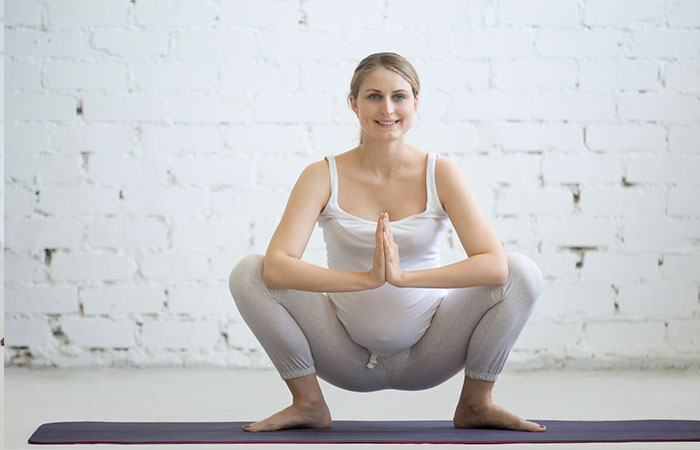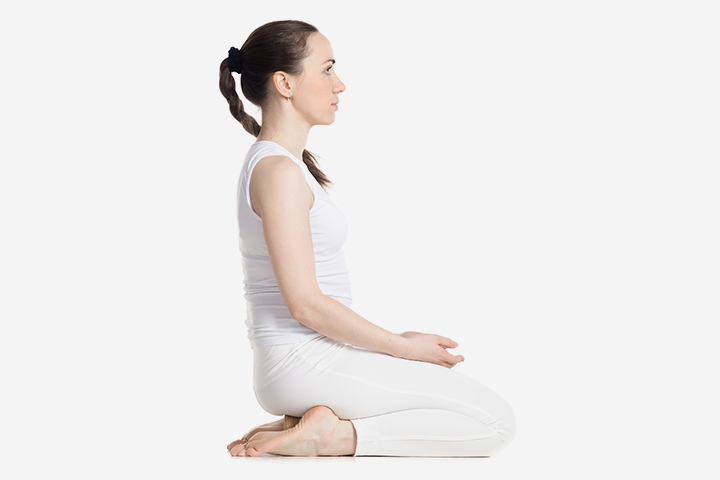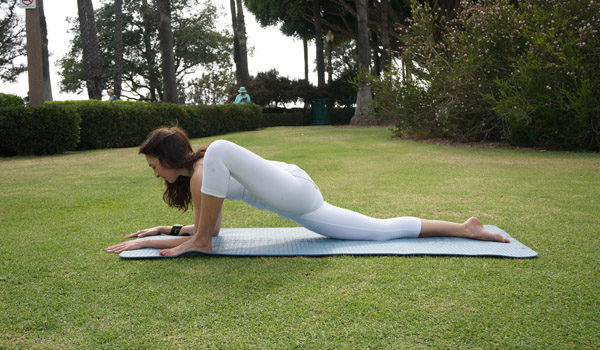Prenatal yoga is designed to improve strength and flexibility in expecting mothers, help prepare the body and the mind for childbirth, and help alleviate symptoms associated with pregnancy. Practicing prenatal yoga may also help reduce depression, stress, and mood swings during your pregnancy. Here’s a prenatal yoga sequence to boost your mood.
1. Vajrasana
Begin on all fours, with the tops of your feet flat on the mat. Shift your weight back, until your hips stack over your heels and your shoulders stack over your hips. Ground your hips down, while lengthening the spine.
Soften the shoulders away from the ears, feeling the upper back relax. Reach the crown of the head up to the sky. Close your eyes, and scan the body from the top of the head to the tips of the toes. Become aware of the breath, and mindfully breathe naturally in and out of the nose.
If you’re quite advanced into your pregnancy and the weight of your upper body is a lot to bear on your heels, feel free to support yourself with a yoga block or bolster underneath your hips. Vajrasana, or thunderbolt pose, helps alleviate lower body discomfort (particularly in the calves and ankles), and helps relieve lower back pain.
2. Cat Cow
Come back to your all fours position. Stack your shoulders over your wrists, and your hips over your knees. If you have tender wrists, pad them with a soft blanket. If this still doesn’t help, feel free to perform this next pose still seated in vajrasana or in sukhasana.
Inhale, lift the tailbone and bring the chest forward. Draw the shoulders back and away from the ears, and gaze up to the sky to stretch your throat. Exhale, round the upper back and draw the scapula away from one another. Try not to brace the belly so much–focus on letting the movement come from the mid-upper back instead.
Repeat this movement a few more times. Bringing the spine across flexion and extension helps unwind the vertebrae and rehydrate your intervertebral discs.
If it feels good, try stretching one leg out, pressing your toes down, and reaching the heel of your foot to the back of the room. Shift your weight forward and back to stretch out the calf muscles and hamstrings. Repeat on the other side.
3. Pigeon
For tight hips and lower back pain, try pigeon pose. From your all fours position, lift your right shin and bring it behind the wrists. Soften your right outer hip down, while lengthening your left leg behind you and relaxing the left thigh down to the mat.
Open up your chest and spread the collarbones. Press the heart forward. While Pigeon may be typically performed with a forward fold, stay upright so as not to compress your belly.
If it’s very hard for you to get your outer hip down to the mat, try padding it with a yoga block, blanket, or bolster. Stay in this shape for a few breaths, focusing on relaxing your hips and breathing in and out naturally and easily. When you’re ready, repeat on the other side.
4. Lizard
After performing Pigeon on the left side, come back to your all fours. Once again, step the right foot forward in between your hands. Walk your right foot to the right side of the mat, placing both hands on the inside of your right ankle.
Support your hands with yoga blocks, or simply rest your forearms on a stack of pillows. Let your left thigh sink towards the mat, feeling the deep stretch across your inner thighs, quadriceps, and hip flexors. Keep your chest reaching forward, your head upright, and your neck long.
To unwind the spine, add an open twist. Take your right hand down, with your forearm and bicep supporting you. Lift your left arm up to the sky and turn your chest to the left side. Feel your chest and your upper back expand as you reach the fingertips up.
Stay here for a few breaths, before lowering the top hand down and switching to the other side.
5. Malasana
After performing Lizard on the left side, step your right foot outside your right hand and your left foot outside your left hand. Sit in a low squat, feeling the slight compression in your ankles and the stretch in your groin. You may support your belly with your hands, or keep your hands in prayer in front of your chest.

Feel free to support your hips with blocks or a stack of bolsters. This pose also helps improve circulation and promotes better digestion during your pregnancy.
This is a prenatal yoga sequence to boost your mood. However, do remember that every pregnancy is unique. Before doing any physical activity during your pregnancy, remember to get medical clearance from your doctor.







